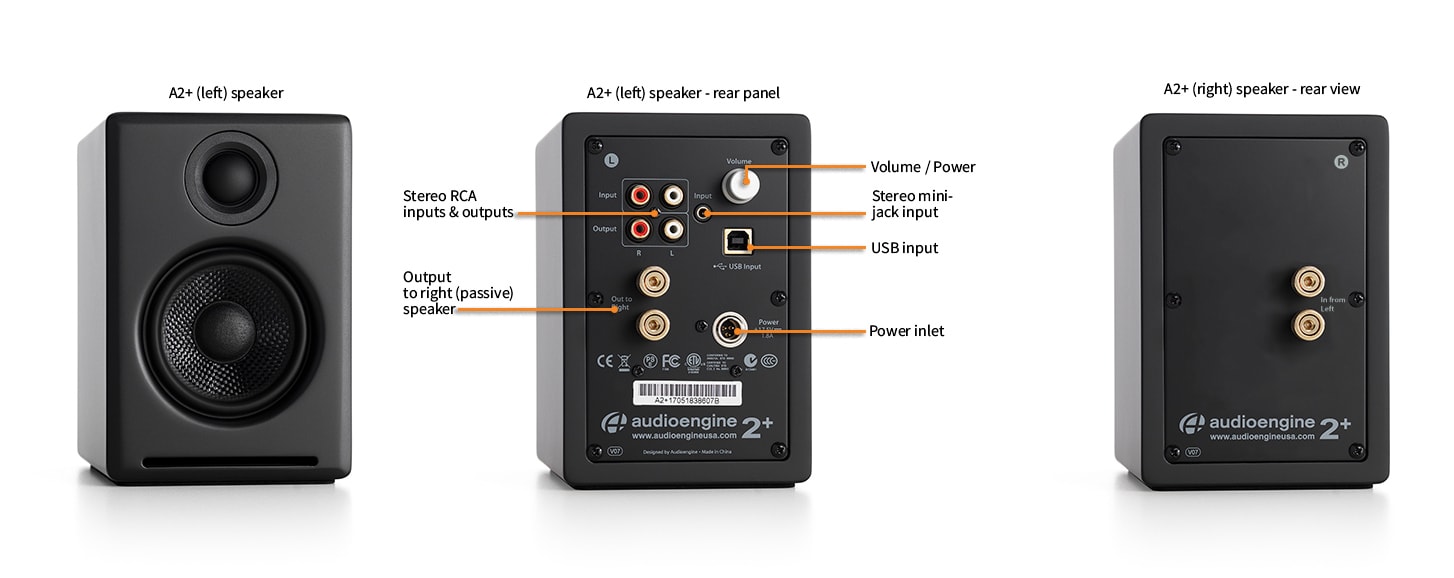Your cart is currently empty!
Technical Specifications

General specifications
Amplifier type
Dual class AB monolithic
Power output
60W peak power total (15W RMS / 30W peak per channel), AES
Drivers
2.75″ aramid fiber woofers, 3/4” silk dome tweeters
Inputs
3.5mm stereo mini-jack, RCA, USB
Outputs
RCA variable line-out
Input voltages
100-240V 50/60Hz auto-switching
SNR
>95dB (typical A-weighted)
THD+N
<0.05% at all power settings
Crosstalk
-50dB
Freq. response
65Hz-22kHz ±2.0dB
Input impedance
10K ohms unbalanced
Protection
Output current limiting, thermal over-temperature, power on/off transient protection
USB specifications
Connector type
USB type-B
USB device class
type 1.1 or above
Internal D/A converter
TI/Burr Brown PCM2704C
Input bit depth
up to 16 bits native
Input sample rate
up to 48KHz native
Weights and measures
Dimensions (each)
6”(H) x 4”(W) x 5.25”(D)
Weight (LEFT speaker)
1.6Kg/3.55lbs
Weight (RIGHT speaker)
1.4Kg/3.15lbs
Shipping weight
4.6kg/10lbs per pair
Shipping box dims
10.5” (H) x 15” (L) x 7” (W)
Finish options
Satin Black Paint
Hi-Gloss White Paint
Hi-Gloss Red Paint
Environmental requirements
Operating temperature: 32° to 95° F
Non-operating temperature: -4° to 113° F
Relative humidity: 5% to 95% non-condensing
Materials and contruction
6.35mm thick MDF cabinets
3/4″ silk dome tweeters with neodymium magnets
2.75″ aramid fiber woofers with advanced voice coils
Included accessories
Speaker wire (16AWG), 2 meters (~6.5 feet)
Power supply
AC power cord
Mini-jack audio cable, 1.5 meters (~5 feet)
USB cable, 1.5 meters (~5 feet)
Microfiber speaker bags
Microfiber power supply bag
Microfiber cable bag
Setup guide
Product line brochure
Custom built
Audioengine designs and manufactures our own tweeters, woofers, and other critical components. In other words, these are not “box built” speakers with off-the-shelf parts but custom-designed to our specifications. What we do not fabricate directly in our factory we have made to our designs (parts such as transformers, magnets, and wiring harnesses, for example). The cabinets, drivers, bass port designs, amplifiers, and crossovers are all painstakingly tuned together for each Audioengine model. This, in turn, makes for a much more efficient system that requires much less power than passive speakers and a separate integrated amplifier or similar A/V components.
Drivers
Audioengine uses audiophile-quality, ferrofluid-cooled silk dome tweeters with neodymium magnets. Silk tweeters hold up well under high power and the edge-driven design gives very smooth response. The woofers are aramid fiber woven glass composite with rubber surrounds. Aramid fiber is obviously very strong, which means that the woofer retains its shape when being driven at high levels. The speaker materials and construction are robust enough to stand up to some serious thrashing, so speaker grills aren’t needed and they will sound and look great after many years of use.
Power amplifiers
The amplifiers in Audioengine speakers are located in the left speaker and are a conservatively rated analog design. All components are tuned together for each model, which provides a much more efficient system requiring less power than passive speakers and separate amplifiers. Circuit boards for the power and preamp sections are mounted for maximum mechanical shock protection.
Power transformers
Power transformers are a large contributor to the overall audio performance, especially in the low end. Again, no off-the-shelf parts. Audioengine uses gapless core toroidal transformers which have a tighter radiated magnetic field, directly translating to lower noise. They are lighter than standard, lower-cost “EI” transformers and also generate less heat.
Shielding
Both drivers are directly video shielded and allow the user to place the speakers within a few inches of a video monitor. This shielding also offers protection for hard-drive digital music players.
Based on studio monitor designs
Studio monitor speakers are used by producers and engineers in recording and production studios. They are designed with a theoretical flat frequency response which allows the engineer to create a final mix in such a way that the recorded music will sound good on most other speakers. Although Audioengine speakers are not designed to be up-close “nearfield” studio monitors, we do carry over much of the same higher-end technology, components, and design philosophy for Audioengine speakers.
Cabinets
To minimize unwanted resonances and distortion, Audioengine cabinets have thick high-resin MDF walls with extensive internal bracing. Heavy internal sound-damping material is used to reduce unwanted sound reflections inside the cabinet. All cabinet edges are rounded which look great and reduce high-frequency diffraction effects on the front baffles. Each cabinet contains tuned, front-port slots. Both speakers are tuned and tested together and sold in pairs.

